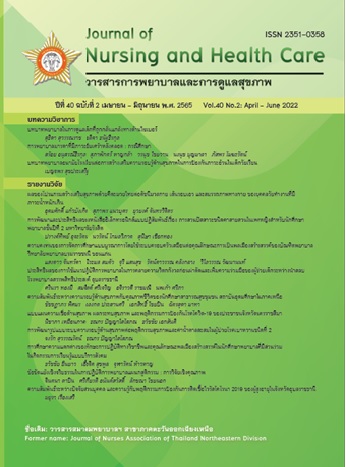การพยาบาลมารดาที่มีภาวะซึมเศร้าหลังคลอด : กรณีศึกษา
คำสำคัญ:
ภาวะซึมเศร้าหลังคลอด, มารดาหลังคลอดบทคัดย่อ
บทความนี้มีวัตถุประสงค์เพื่อนำเสนอความรู้เกี่ยวกับภาวะซึมเศร้าหลังคลอดและการพยาบาลมารดาหลังคลอดที่มีภาวะซึมเศร้า จากการทบทวนวรรณกรรมและประสบการณ์การดูแลมารดาหลังคลอดที่มีภาวะซึมเศร้า ภาวะซึมเศร้าหลังคลอดเป็นความแปรปรวนด้านอารมณ์ พบมากในช่วง 4-6 สัปดาห์หลังคลอด และอาจเกิดขึ้นได้ในระยะ 2-3 วันหลังคลอด อุบัติการณ์แตกต่างกันตามระยะเวลา ช่วงเวลาประเมินหลังคลอด เครื่องมือและเกณฑ์ที่ใช้ในการประเมิน ลักษณะกลุ่มตัวอย่าง สถานการณ์ และสถานที่ทำการประเมิน พบอัตราภาวะซึมเศร้าหลังคลอดได้ตั้งแต่ร้อยละ 5.2-37.3 ภาวะซึมเศร้าหลังคลอดมีผลกระทบต่อการดำเนินชีวิตและคุณภาพชีวิตของมารดาหลังคลอดและทารก มีโอกาสเจ็บป่วยและเข้ารับการรักษามากกว่ามารดาและทารกทั่วไป สัมพันธภาพกับทารกและครอบครัวลดลง และเพิ่มภาระในการดูแล ปัจจัยที่มีความสัมพันธ์กับภาวะซึมเศร้าหลังคลอดมีทั้งปัจจัยด้านมารดา ทารก สังคม สิ่งแวดล้อม และครอบครัว การดูแลมารดาที่มีภาวะซึมเศร้าหลังคลอดที่สำคัญ คือ การดูแลด้านจิตใจ จิตสังคม ร่วมกับการดูแลทางด้านร่างกาย เป้าหมายการดูแลมารดาหลังคลอดที่มีภาวะซึมเศร้าจากกรณีศึกษาที่สำคัญคือ การสร้างความผูกพันธ์ในครอบครัว การยอมรับของครอบครัว และการปรับตัวต่อบทบาทมารดา
Downloads
เอกสารอ้างอิง
Lowdermilk D, Perry S, Cashion K. Maternal and women’s health care. 10th ed. USA: Elsevier; 2012.
Marshall JE, Raynor MD. Myles textbook of midwives. 17th ed. Poland: Elsevier; 2020.
Giallo R, Saymour M, Dunning M, Cooklin A, Loutzenhise L, McAuslom P. Factors associated with the course of maternal fatigue across the early postpartum period. J Reprod Infant Psychol 2015; 33(5): 528-44.
Hassanzadeh R, Abbas-Alizadeh F, Meeda S, Alizadeh-Charandabi SM, Mirghafourvand M. Fear of childbirth, anxiety and depression in three groups of primiparous pregnant women not attending, irregularly attending and regularly attending childbirth preparation classes. BMC Women’s Health 2020; 20(180): 1-8.
Srisawad K, Panyapinitnukul C, Sonnark N. Health Promoting Behavior in Pregnancy. Songklanagarind Journal of Nursing 2018; 38(2): 95-109.
Drake E, White MS. Postpartum adaptations and nursing care. In Murray S, Mckinney E, Holub KS, Jones R. (eds). Foundations of maternal-newborn and women’s health nursing. 7th ed. St. Louis Missouri: Elsevier; 2019. pp. 458-64.
Gulamani SS, Premji SS, Kanji Z, Azam ZI. A Review of postpartum depression, preterm birth, and culture. J Neonatal Nurs 2013; 27(1): 52-9.
Prechon K. Postpartum depression: prevention and care. Thai Red Cross Nursing Journal 2016; 9(2): 24-35.
Callahan TL. Tarascon’s OB/GYN pocketbook. Burlington, MA: Jones & Bartlett Learning; 2016.
Ricci SS. Essentials of maternity newborn and women’s health nursing. 4th ed. Philadelphia: Lippincott Williams & Wilkins; 2017.
Kittichotiwat W. Prevalence and factors associated with postpartum depression at Kaeng Khoi Hospital. Saraburi Province. J DMS 2018; 43(5): 125-30.
Anusornteerakul S, Ounkaew A, Harnklar S, Sitthi K, Booranasun T, Chaiwan W. Prevalence of Postpartum Depression During the Outbreak Situation of Coronavirus 19. Journal of Nursing and Health Care 2022; 40(1): 94-101.
Duang-iad K. Prevalence of postpartum depression in adolescent mothers at Khuan Khanun Hospital. J Med Syst 2018; 31(3): 457-64.
Lertsakornsiri M, Boonyanurut P, Deoisres W, Hisako K. Relationship between stress, social support, self-esteem and depression in postpartum mothers. Thai J Nurs 2012; 61(3): 1-8.
Rogers CE, Kidokoro H, Wallendorf M, Inder TE. Identifying mothers of very preterm infants at-risk for postpartum depression and anxiety before discharge. J Perinatol 2013; 33(3): 171-6.
Phumek S, Kovavisarat E, Kuanphakul M, Sangpitak W. Factors predicting depression of postpartum mothers who come to Rajavithi Hospital. J Nurs Healthc Res 2019; 35(3): 158-70.
Sriarporn P, Suntornlimsiri N, Juntratit K, Deeluea J, Nunchai J, Khiaokham P. Factors of related to postpartum depression among first time mother and father. J Nurs 2015; 42(3): 37-50.
Figueiredo B, Canário C, Field T. Breast feeding is negatively affected by prenatal depression and reduces postpartum depression. Psychol Med 2014; 44(05): 927-36.
Freeley N, Bell L, Hayton B, Zelkowitz P, Carrier ME. Care for postpartum depression: what do women and their partners prefer? Perspect Psychiatr Care 2016; 52(2): 120-30.
Bang KS, Kang HJ, Kwon MK. Relations of postpartum depression with socio-demographic and clinical characteristics of preterm infants and mothers. Child Health Nurs Res 2015; 21(1): 1-10.
Alkozei A, McMahon E, Lahav A. Stress levels and depressive symptoms in NICU mothers in the postpartum period. J Matern Fetal Neonatal Med 2014; 27(17): 1738-43.
Kiruthiga V. Emotive whims distressing pregnant women. Int J Eng Sci Technol 2017; 4(8): 2194-6.
Reid KM, Taylor MG. Social support, stress, and maternal postpartum depression: a comparison of supportive relationships. Soc Sci Res 2015; 54: 246-62. doi: 10.1016/j.ssresearch.2015.08.009.
Cook N, Ayers S, Horsch A. Maternal posttraumatic stress disorder during the perinatal period and child outcomes: a systematic review. J Affect Disord 2018; 225: 18-31.
de Groaff LF, Honig A, van Pampus MG, Stramroods CA. Preventing post-traumatic stress disorder following childbirth and traumatic birth birth experience: a systematic review. Acta Obstet Gynecol Scand 2018; 97(6): 648-56.
Ferrari G, Agnew-Davies R, Bailey J, Howard L, Howarth E, Peters JT, Sardinha L, Feder GS. Domestic violence and mental health: a cross sectional survey of women seeking help from domestic violence support services. Glob Health Action 2016; 8(9): 29890. doi: 10.3402/gha.v9.29890
Department of Health, Ministry of Public Health. Maternal and Child Health Diary. Nonthaburi: Department of Health, Ministry of Public Health; 2020.
Nuanchawee W, Kasiphon T, Nateethanasombat K. The prevalence of postpartum depression and factors predicting depression in postpartum mothers. HCU Journal 2018; 21(42): 65-77.
ดาวน์โหลด
เผยแพร่แล้ว
รูปแบบการอ้างอิง
ฉบับ
ประเภทบทความ
สัญญาอนุญาต
ลิขสิทธิ์ (c) 2022 วารสารการพยาบาลและการดูแลสุขภาพ

อนุญาตภายใต้เงื่อนไข Creative Commons Attribution-NonCommercial-NoDerivatives 4.0 International License.



